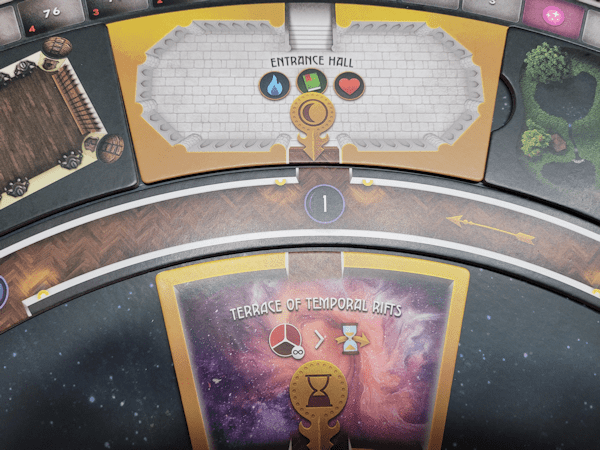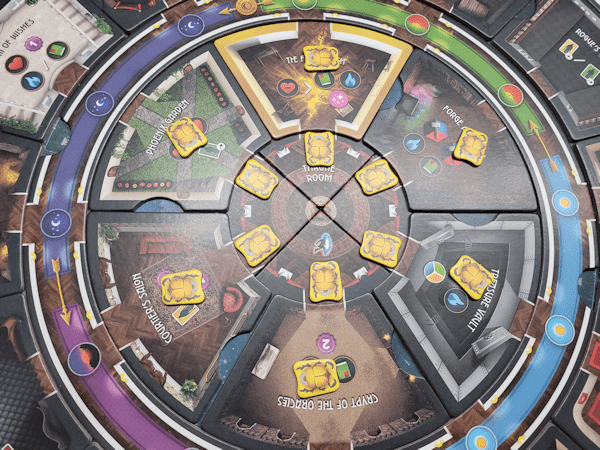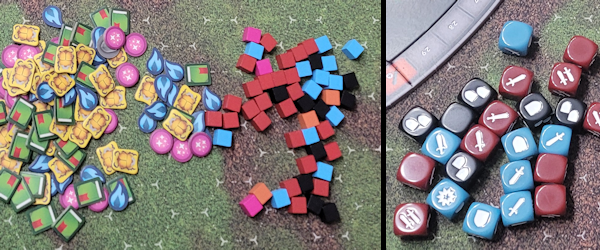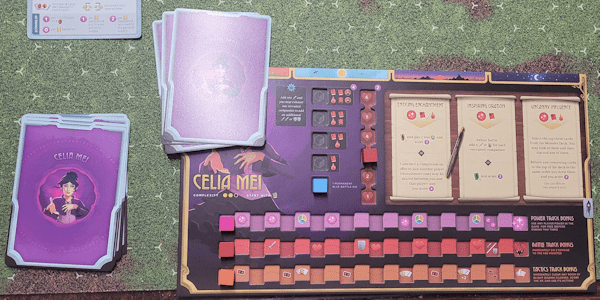Disclosure: Meeple Mountain received a free copy of this product in exchange for an honest, unbiased review. This review is not intended to be an endorsement.
The game of Weirdwood Manor begins with a narrative explaining the situation. Lady Weirdwood rules over a magical mansion that stands as the nexus between the mortal realm and the lands of the fae. It is her job (along with her wardens—that would be the players) to keep the forces of evil at bay. However, something has gone wrong and some evil from the Fae Realm has breached the manor and has come to wreak havoc.
The setup is quite interesting. Everything within the game, from the way the manor works to the interesting abilities of the various characters you can play to how the secondary characters (called companions) operate… all serve this theme admirably.
What follows is a look at how the game is set-up and played. If you want to skip this, continue on to my thoughts below. Otherwise, click on the link and check out how the game functions!
Setup
Setup is relatively straight forward, even though it is a lot of steps.
First there is the main board setup:
- Assemble the two halves of the manor.
- Place the outer-ring rooms into their ring in a random order.
- Assemble and place the Day Corridor and place it just inside the outer-ring rooms with Day 1 at the top of the board.

- Place the middle-ring rooms into their ring in a random order.
- Place the Time of Day Corridor just inside the middle-ring rooms with the first morning space at the top of the board.

- Place the inner-ring rooms into their ring in a random order.
- Place six scarab tokens in the innermost room (the Throne Room).
- Place one scarab token in each of the inner-ring rooms.
- Place three scarab tokens into random rooms in the manor (at this point, no room may have more than one scarab within it).

- Shuffle the companions deck and place four companions face-up as the current market.
- Shuffle the warden tactics deck and place it near the board.

- Place the tokens (scarabs, min, knowledge, and power), cubes, and dice near the board.

Then there is the player setup:
- Each player selects a warden and takes the player board associated with the chosen warden. Then they…
- …place a blue cube in their Battle Die track.
- …place a red cube in the 3-space of their Health track.
- …place a pink cube at the start of their Power experience track.
- …place a red cube at the start of their Battle experience track.
- …place an orange cube at the start of their Tactics experience track.
- …place any resources/power tokens the warden starts with into their supply.
- Players take their corresponding standees. These are placed in the Entrance Hall at the top of the board.
- Players take their personal Action Card Deck, remove the Shadow Steps card (this card is always in the player’s starting hand), shuffle the remaining cards, and deals out two additional cards to form their starting hand.

And finally, there is the fae monster setup. This is different for each of the three monsters.

Playing the Game (Abridged)
Weirdwood Manor is a cooperative game. A player’s turn consists of playing an action card from their hand (mandatory) and taking any optional actions (see below) they wish to take. If the player has a warden tactics card in their hand, they can play it to enhance the action card.

When they play an action card, it will be played to one of the positions at the top of their player board. The position chosen must not have an action card already in it. These positions are associated with a time of day: morning, afternoon, evening, or night.
Once played, before anything else happens, the time of day corridor is advanced (i.e., rotated counter-clockwise) at least one space; it must stop in such a way that the one of the three time of day spaces that matches the time of day where the action card was played is at the topmost location. Which of the three is used is up to the player.
If the time of day corridor moves such that the topmost space passes from night back to morning, then the day corridor is also advanced to the next day. This can trigger the end of the game (see below).
The movement of these two corridors is vitally important! As they rotate, rooms in the manor can become isolated. This can result in players (or the fae monster) being trapped in a room until the corridor’s rotate again. This is why it is important to carefully select which of the three spaces for that time of day to use.

Standard Actions
There are several standard actions that can be acquired via the action card selected: these include:
- Move: via this action, a warden can move to any room in the manor so long as they can trace a path of corridors and rooms that is not blocked. A move cannot go through a room with an adversary; if a warden enters such a room, the move ends. If they have another move, they can leave that room and continue on to another.
- Portal: via this action, a warden can teleport from their current room into any other room in the manner. No unblocked path needed.
- Attack: via this action, a warden can initiate combat. If any scarabs are in the room, they are what is being attacked; if the fae monster is in the room and there are no scarabs, the warden can attack the fae monster. Attacks are described in more detail below.
- Gain Resources: via these actions, a warden acquires more resources.
If the warden moves to, or has combat in, a room that has no adversaries (either because it had none to begin with, or because they were defeated), they may perform the actions that the room provides. Rooms have the ability to grant resources, acquire warden tactic cards, recruit companions, craft battle dice, and so on. The actions provided by rooms (and special abilities, etc.) include:
- Forging Battle Dice: via this action, a warden may acquire more dice to be used in combat. There are three types of dice that can be forged: red dice which focus on offense, black dice which focus on defense, and blue dice which are a balance of the two. Attacks are described in more detail below.
- Recruit Champions: via this action, a warden may recruit a companion. Companions have a cost in resources (which grows with each additional companion recruited). Companions provide the warden two things: an optional action they can use, and additional spaces in which they can play action cards.
Optional Actions
As mentioned above, players can also perform optional actions in addition to their actions from action cards and rooms. Optional abilities can be played before or after playing an action card. There are three optional actions:
- Character Abilities: wardens each have three special abilities that have a cost to activate. Each power can be activated once per turn.
- Companion Abilities: companions have special abilities that usually require that they be exhausted (flipped over). Once exhausted, the ability cannot be used again until the companion is refreshed.
Experience
Along the bottom of the player boards are three experience tracks. Many things (mostly combat) will result in the player gaining experience. Each point of experience earned moves any one of the experience track markers along their track.
As the marker reaches certain thresholds, the warden will gain things like power tokens, resources, healing, or even swords (extra damage) and shields (protection from damage) in all future combats. Winning this game is as much about managing your experience as it is managing the adversaries on the board.
End of the Turn
Once a player has performed all the actions they are going to perform, their turn ends. This means:
Monster Phase: the fae monster performs an action. This action comes from their specific deck of cards and will involve advancing the time of day corridor a number of spaces, the moving or attacking or gathering power. As the game gets further along, the power of these actions increases.
Scarab Phase: Remember when I said that action cards must be placed into a time of day position above the player board? Remember when I said that companions add positions that can be used for additional action cards?
Well, this is important because if all of the positions are filled, then at the end of the player’s turn, a special scarab phase takes place.
In this phase, more scarabs spawn, the ones that were already there move around, all of the action cards you have in play are discarded, and your companions are refreshed. The spawning and movement of scarabs is the dangerous part here: if two or more scarabs occupy the same room (other than the Throne Room), that room becomes blighted. Blighted rooms are flipped over and cannot be used until the blight is removed. To remove blight, the scarabs need to be dealt with, then a warden in that room needs to pay a price specific to that room.
Action Cards Phase: once the fae monster has completed its action, and the scarab phase is complete (assuming it took place), then the player adjusts their hand to have e number of cards equal to their current health (1 thru 6). If they have too many cards, they discard; if they have too few cards, they draw.
Combat
Combat is a big part of what will be happening in the game. Wardens can initiate combat via the attack action; the fae monster can initiate combat during the monster phase.
Combat comes down to this:
- The warden sums up the total number of swords and shields they have as bonuses on cards they have in play, as well as the bonuses on their experience tracks.
- Then they add the result of the rolling of all battle dice they have.
- Once they have these totals, the adversaries roll their battle dice.
Compare the number of swords the warden has to the number of shields the adversary has. Each sword in excess of the shields deals one damage to the adversary. Each scarab can take one point of damage; each fae monster is unique in how it deals with damage.
Compare the number of swords the adversary has to the number of shields the warden has. Each sword in excess of the shields deals one damage to the warden. Damage can be taken as health, battle dice, or power tokens. Any excess damage is ignored.
Blue battle dice have a special surge icon on one side. The effect of this icon is specific to each warden and fae monster. For scarabs, when they roll a surge, they attempt to escape into a different room.
The warden’s bonuses, as stated above, can come from their experience and the action cards in play (sword and shield symbols on the cards themselves). In addition, the cards in play that are adjacent to one another can also provide bonuses.

This provides an additional layer of thinking that goes into where an action card is played. Warden tactics cards add more bonuses to the action cards as well as providing wildcard symbols in the upper corners. These match anything on the adjacent cards. Two wildcard symbols can be used for any of the four bonuses pictured above. These bonuses remain for as long as the cards are in play. When a scarab phase takes place, all cards the warden has in play are discarded and those bonuses will all end.
End of the Game
The end of the game is triggered in one of three ways:
- If the day corridor is advanced past the 12th day, the game is over and the players have lost.
- Each fae monster has one or more game end triggers. If any of these triggers are met, the game is over and the player’s have lost.
- If the fae monster is reduced to zero health, the game ends and the players have won.
My Thoughts
There is a lot going on with Weirdwood Manor. In any given game, you are monitoring…
- …your warden’s resources, experience, abilities, and health.
- …your action cards and what persistent bonuses they are currently providing.
- …your companions and what abilities they can provide.
- …the manor’s current day and time of day corridor positions.
- …where the scarabs and the fae monster are located.
- …the number of rooms that have been blighted (or even destroyed via the Chaos Ogre).
It can seem like it is just too much the first time you play. But to be honest, the icons and symbols are well designed and become fairly easy to read after a game or two. Moving the time of day and day corridors can be fiddly, but they quickly become second nature. The pathways of available rooms for movement is something that will throw you for a bit, but your eyes will lock onto open and blocked passages in no time.
The workings of the manor change with each random placement of the rooms. The game comes with some expansion rooms that can spice things up, just be wary of the selection of used rooms if you happen to exclude the rooms that allow for companions (this is possible, but easily rectified). Add in the number of potential companions, warden tactic cards, and so on… what you have is a game with a lot of variability. And one that can be a bit of a table hog.
The bottom line is that this game works!
It can be intimidating. That said, in my very humble opinion, there are two types of complexity a game can have. The first type is bad—this is complexity for the sake of complexity. The second type is good—this is complexity that serves the game and enhances the theme.
One of the most complex games I have ever played is Starfleet Battles. This game of starship combat has—literally— over 300 pages of rules. Those rules are in a small font on pages broken into multiple columns and organized like an engineering textbook. That said, there is not a single word in that rulebook that does not serve to enhance the theme of the game. Once you have the basics down (which does not take that long), you are no longer looking up rules to see what you can do, you are figuring out what you want to do and looking up the rules that tell you how to do that. The game is exceedingly complex, but it is just about perfect for what it does.
The complexity in Weirdwood Manor is all good complexity. What you are doing feels like you are a powerful warden with their trusty companions protecting an extra dimensional house from magical creatures. Each character feels unique. Each fae monster feels unique. Every random element and choice during setup has a real impact on how you approach the game.
If only the rulebook were better organized.
If you are a regular reader of Meeple Mountain, you have likely seen some reviews where the quality of the writing and/or organization for the rulebook is an issue. Weirdwood Manor is yet another game where this is true. The game has some complexity, but the rulebook would give you the impression that they are vastly more complex. Too many poorly organized rulebooks, not enough editors it would seem.
I really like Weirdwood Manor. Although I feel like I could use some clarification on a rule or two, the rules melt into the theme beautifully. The game has no solo mode, per se; the rules state that to play solo, pick two wardens and go for it! I played this way a few times and it works very well. This is one of the better cooperative games I have played.
What are you waiting for? Go get yourself a copy of Weirdwood Manor!












Add Comment